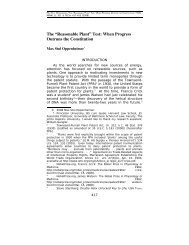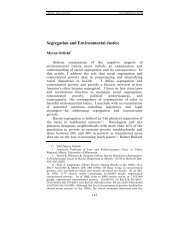An Organizational Approach to the Design of Patent Law
An Organizational Approach to the Design of Patent Law
An Organizational Approach to the Design of Patent Law
Create successful ePaper yourself
Turn your PDF publications into a flip-book with our unique Google optimized e-Paper software.
6 VERTINSKY FINAL_JAD (DO NOT DELETE) 2/27/2012 2:20 PM<br />
2012] AN ORGANIZATIONAL APPROACH 261<br />
for example, and where norms for flexible use <strong>of</strong> and respect for<br />
patent rights emerge, <strong>the</strong> formal institution <strong>of</strong> patent law may<br />
become more effective as a <strong>to</strong>ol for innovation. Similarly, where<br />
<strong>the</strong> system is regarded as exploitative or inefficient, or norms<br />
develop which involve ignoring intellectual property rights, <strong>the</strong><br />
effectiveness <strong>of</strong> <strong>the</strong> patent system may decline. Examples <strong>of</strong> patent<br />
law research beginning <strong>to</strong> take place at this level include<br />
<strong>the</strong> study <strong>of</strong> how norms <strong>of</strong> information production and information<br />
sharing develop and interact with formal rules, such as<br />
<strong>the</strong> allocations <strong>of</strong> property rights. 216 Studies <strong>of</strong> creativity and<br />
processes <strong>of</strong> scientific discovery can suggest characteristics that<br />
may usefully inform <strong>the</strong> construction <strong>of</strong> patent laws. 217<br />
Informal rules—level two <strong>of</strong> <strong>the</strong> framework—play an important<br />
role in <strong>the</strong> development and dissemination <strong>of</strong><br />
knowledge, and in <strong>the</strong> interaction <strong>of</strong> norms <strong>of</strong> “free” or “semifree”<br />
information sharing with patent law; this is a subject <strong>of</strong><br />
growing concern, particularly in <strong>the</strong> context <strong>of</strong> academic science.<br />
218 Alternative modes <strong>of</strong> innovation emerge that are constructed<br />
around norms <strong>of</strong> open access. Consider, for example,<br />
user innova<strong>to</strong>rs—or lead users—who develop technology for<br />
<strong>the</strong>ir own use, and are involved in free innovation transfers.<br />
These “lead users” innovate in order <strong>to</strong> solve <strong>the</strong>ir own ahead <strong>of</strong><br />
market needs, providing new and improved products, <strong>of</strong>ten<br />
without any intent or action <strong>to</strong> patent <strong>the</strong>ir contributions. 219<br />
216. This has been <strong>the</strong> subject <strong>of</strong> much discussion in <strong>the</strong> context <strong>of</strong> patent<br />
rights obtained over <strong>the</strong> fruits <strong>of</strong> basic research. See Robert P. Merges, A New<br />
Dynamism in <strong>the</strong> Public Domain, 71 U. CHI. L. REV. 183, 197 (2004) (discussing<br />
concerns about <strong>the</strong> “propertization” <strong>of</strong> <strong>the</strong> public domain); see also Eisenberg,<br />
<strong>Patent</strong>s and <strong>the</strong> Progress <strong>of</strong> Science: Exclusive Rights and Experimental<br />
Use, supra note 35.<br />
217. See, e.g., Fromer, supra note 215.<br />
218. See, e.g., Rebecca S. Eisenberg, Proprietary Rights and <strong>the</strong> Norms <strong>of</strong><br />
Science in Biotechnology Research, 97 YALE L.J. 177, 217–26 (1987) (discussing<br />
<strong>the</strong> conflict between exclusive rights in research discoveries and academic<br />
norms); Heller & Eisenberg, supra note 205, at 698; Robert P. Merges, Property<br />
Rights Theory and <strong>the</strong> Commons: The Case <strong>of</strong> Scientific Research, 13 SOCIAL<br />
PHILOSOPHY & POLICY 145 (1996).<br />
219. See Fred Gault & Eric von Hippel, The Prevalence <strong>of</strong> User Innovation<br />
and Free Innovation Transfers: Implications for Statistical Indica<strong>to</strong>rs and Innovation<br />
Policy at 3 (MIT Sloan Sch. Mgmt., Working Paper No. 4722-09,<br />
2009), available at http://ssrn.com/abstract=1337232 (<strong>to</strong> access article, select<br />
One-Click Download) (arguing that statistical indica<strong>to</strong>rs <strong>of</strong> innovation activities<br />
should be modified <strong>to</strong> reflect <strong>the</strong> importance <strong>of</strong> user-innova<strong>to</strong>rs in producing<br />
product and process innovations and that given <strong>the</strong> significance <strong>of</strong> this<br />
“free” innovation we should be more skeptical about <strong>the</strong> need for strong patent<br />
rights).






